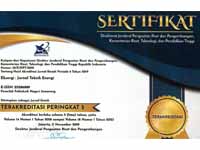Development of a MATLAB GUI Application for Computing Reliability Indices at an Electrical Substation
DOI:
https://doi.org/10.32497/eksergi.v21i02.6844Keywords:
MATLAB, GUI, SAIFI, SAIDI, CAIDI.Abstract
The reliability of power distribution systems plays a crucial role in ensuring the continuous and efficient supply of electricity to consumers. This study presents the development of a MATLAB-based Graphical User Interface (GUI) application designed to compute key reliability indices, including SAIFI (System Average Interruption Frequency Index), SAIDI (System Average Interruption Duration Index), and CAIDI (Customer Average Interruption Duration Index), specifically for electrical substations. The application was developed using MATLAB's App Designer and structured to provide an intuitive and interactive user experience. Real operational data from a 150 kV substation were utilized to test and validate the application’s functionality. The results demonstrate that the tool effectively simplifies the reliability analysis process, reduces calculation time, and minimizes the potential for manual errors. This application can serve as a practical support system for engineers and researchers in evaluating and improving the performance of electrical distribution systems.
References
[1] Parol, M., Wasilewski, J., Wojtowicz, T., Arendarski, B., & Komarnicki, P. (2022). Reliability Analysis of MV Electric Distribution Networks Including Distributed Generation and ICT Infrastructure. Energies, 15(14), 5311. https://doi.org/10.3390/en15145311
[2] Prasetia, A. M., Linda Sartika, & Al Amin Hanifa Muslim. (2024). Evaluation of 20 KV Distribution System Using SAIDI and SAIFI Reliability Indices at PT PLN. Emitor: Jurnal Teknik Elektro, 24(2), 115–120. https://doi.org/10.23917/emitor.v24i2.2482
[3] Mandefro Teshome, Fsaha Mabrahtu. (2020). Reliability Assessment and Study the Effect of Substation Feeder Length on Failure Rate and Reliability Indices. American Journal of Electrical Power and Energy Systems, 9(3), 41-46. https://doi.org/10.11648/j.epes.20200903.11.
[4] Hajian-Hoseinabadi, Hamze. (2010). Reliability and component importance analysis of substation automation systems. International Journal of Electrical Power & Energy Systems - INT J ELEC POWER ENERG SYST. 49. 10.1016/j.ijepes.2010.06.012.
[5] Myhre, Stine & Fosso, Olav & Heegaard, Poul & Gjerde, O.. (2021). A Tool for Reliability Assessment of Smart and Active Distribution Systems -- RELSAD. 10.48550/arXiv.2111.01195.
[6] Abboud Khoury, Muhammed Hassanain and M.Sc. Qusay Abdel Latif (2021). Transient Stability GUI with Matlab App Designer (https://www.mathworks.com/matlabcentral/fileexchange/<...>), MATLAB Central File Exchange. Retrieved April 23, 2021.
[7] Cristobal, J. R., & Santiago, R. V. M. (2025). Reliability Assessment of Power Distribution System in Freeport Area of Bataan. Engineering Proceedings, 92(1), 58. https://doi.org/10.3390/engproc2025092058
[8] Arya, R. (2016), Determination of customer perceived reliability indices for active distribution systems including omission of tolerable interruption durations employing bootstrapping. IET Gener. Transm. Distrib., 10: 3795-3802. https://doi.org/10.1049/iet-gtd.2016.0198
Downloads
Published
Issue
Section
License
Copyright (c) 2025 Amrisal Kamal Fajri, Erwan Tri Efendi, Bah Evan, Eri Prihatmini

This work is licensed under a Creative Commons Attribution 4.0 International License.
Authors who publish with this journal agree to the following terms:Authors retain copyright and grant the journal right of first publication with the work simultaneously licensed under a Creative Commons Attribution License that allows others to share the work with an acknowledgement of the work's authorship and initial publication in this journal.
Authors are able to enter into separate, additional contractual arrangements for the non-exclusive distribution of the journal's published version of the work (e.g., post it to an institutional repository or publish it in a book), with an acknowledgement of its initial publication in this journal.
Authors are permitted and encouraged to post their work online (e.g., in institutional repositories or on their website) prior to and during the submission process, as it can lead to productive exchanges, as well as earlier and greater citation of published work (See The Effect of Open Access).






